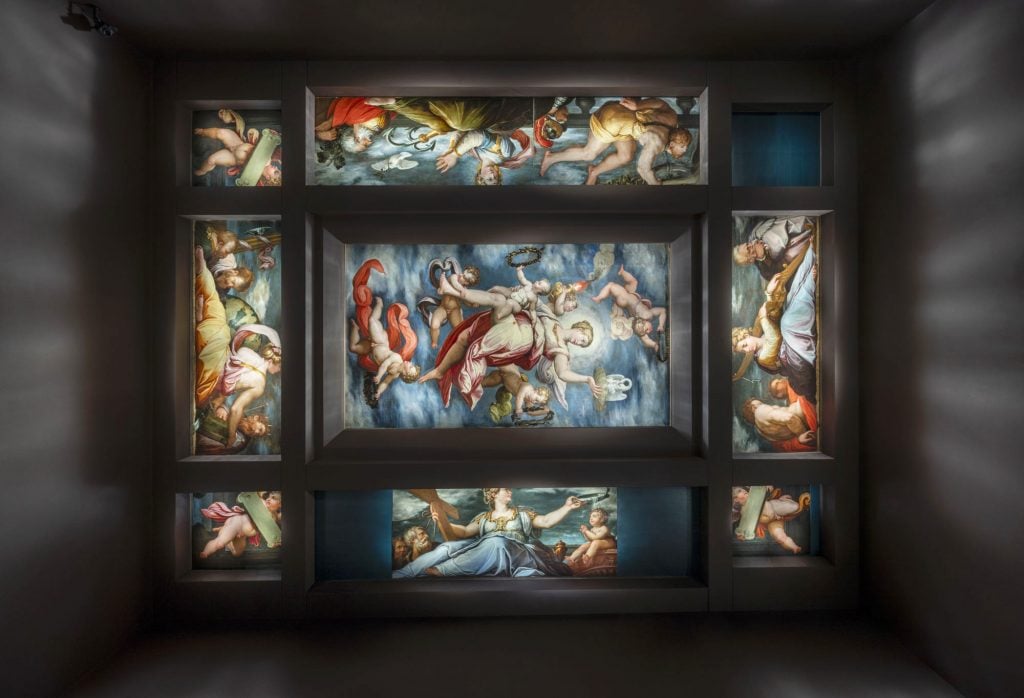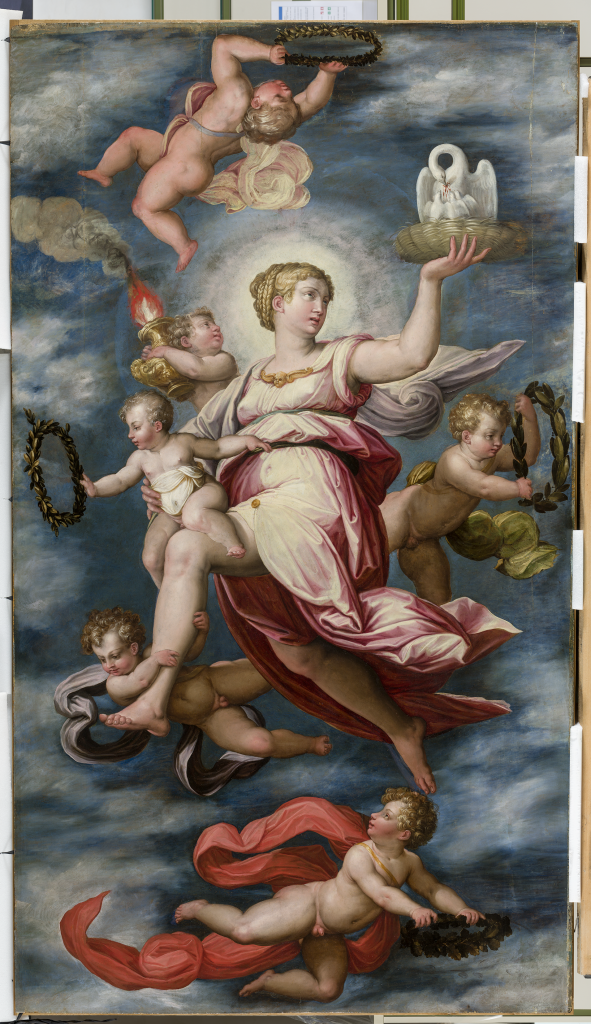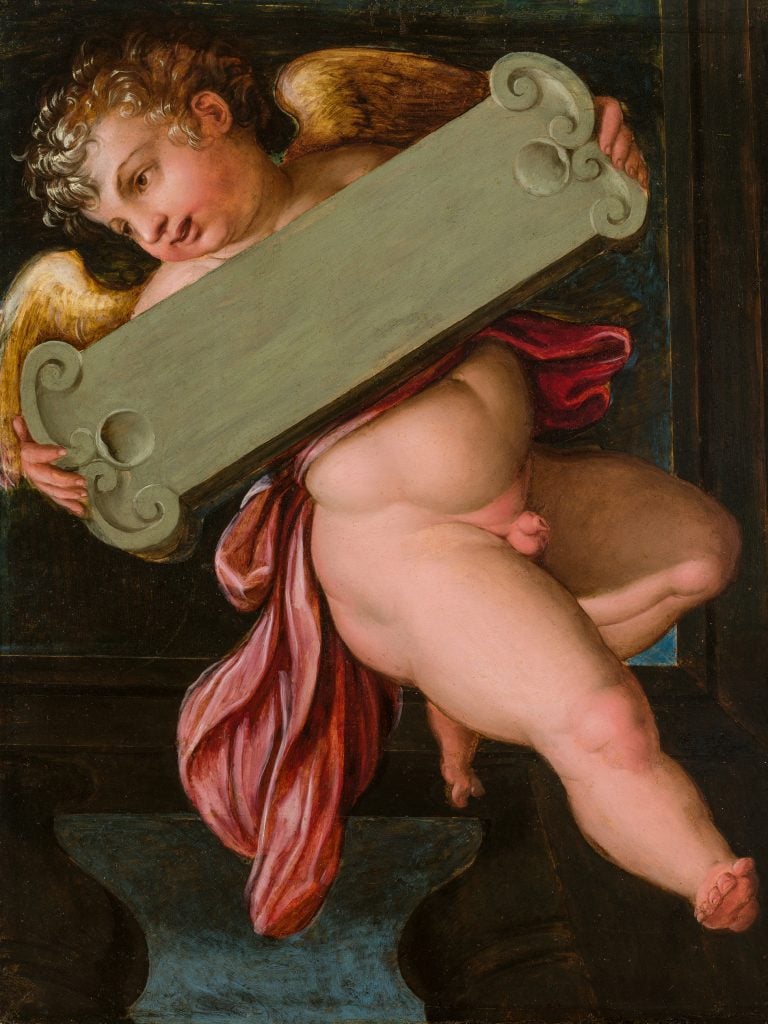Art World
Vasari’s Ceiling Masterpiece, Broken Up for Centuries, Is Finally Reunited
Vasari's painting depicted the five virtues surrounded by cherubs.

In 1541, Venetian nobleman Giovanni Corner was riding high. Still in his thirties, Corner occupied a lofty position in the Republic’s governing body and had recently purchased a Renaissance-style palazzo on the Grand Canal. To embellish the building’s interior, he turned to Giorgio Vasari whose Mannerist paintings were highly fashionable.
For the coffered ceiling of the palazzo’s camera nova, Vasari floated a grand celestial scene extolling the five virtues. Charity hovered at the center. She’s personified by a maiden in flowing scarlet robes who lifts up a basket bearing a mother bird that pierces itself to feed its offspring. Allegorical visions of Hope, Faith, Patience, and Justice encircle her with the room’s corners occupied by four putti, chubby cherubs.
Spread across nine panels, the work graced the Palazzo Corner-Spinelli for more than 200 years, standing as a reminder of why Vasari proved so influential upon the likes of Tintoretto and Titian. Then, in the mid-18th century, the wooden ceiling was gradually broken up and scattered across private European collections.

Giorgio Vasari, Charity (1541). Photo: Gallerie dell’Accademia/Matteo De Fina.
This was deemed a great shame by Venice’s authorities and so, in 1980, a process to locate and recover Vasari’s masterpiece was initiated in coordination with Italy’s Ministry of Culture. Now, after more than 40 years of painstaking research and restoration, the ceiling has been reassembled and returned to public view in a specially designed room at Venice’s Gallerie dell’Accademia. The fillip? It’s the 450th anniversary of the death of the Tuscan painter.
“The recomposition of Vasari’s work adds an important piece to the understanding and reading of the history of art,” said culture minister Gennaro Sangiuliano in a statement. “The panels painted by the genius from Arezzo can finally be returned to the public.”
The first panel was unwittingly reacquired in 1980. Some of the panels were cut in two and when the State purchased a small painting on wood depicting the death of Judas, it sent the work to the Vasari House Museum in the painter’s hometown of Arezzo, unaware that it belonged to the allegory of Hope. This speaks to an aspect of the painting that has only been belatedly realized by art historians: Vasari balanced a positive portrayal of each virtue with a negative example.

Giorgio Vasari, Hope (1541). Photo: Gallerie dell’Accademia/Matteo De Fina.
Momentum picked up in 1987 through the sweeping acquisitions of the panels of Justice, Patience, and a pair of putti. A breakthrough came in 2002 when the Gallerie dell’Accademia secured the work’s centerpiece, Charity, which had belonged to Pinacoteca di Brera, Milan’s main public gallery, since the 19th century. Faith was found in London in 2013 and with the acquisition of Hope four years later, plans on how and where to showcase Vasari’s work were set in motion.

Giorgio Vasari, Putti (1541). Photo: Gallerie dell’Accademia/Matteo De Fina.
First, however, the panels needed to be restored, no simple task given each had received markedly different treatment over the past 300 years. Vasari’s fluid style of loose details worked when seen from a distance below, but up close they appear sketchy and had been altered. “Chastening garments” had been added to the putti, a range of varnishes had been added, and wood-eating insects had bored into several panels. The greatest loss, said restorer Rossella Cavigl, is the disappearance of the richly decorated frame that wove the panels together.
Two fragments remain outstanding, the final putto and the portion cut away from Faith. There’s space for them in the Venice installation, if and when they reappear.





